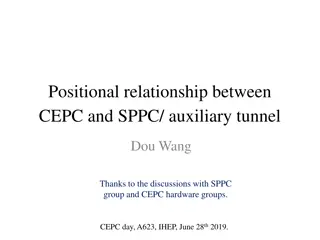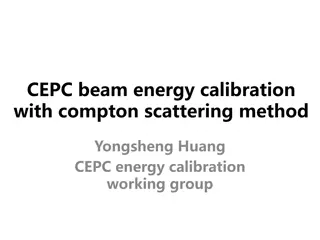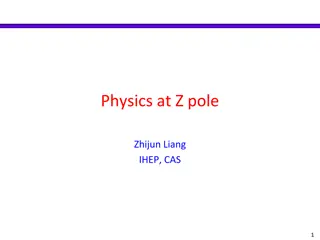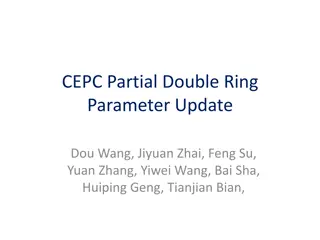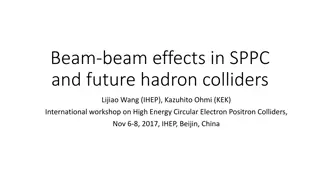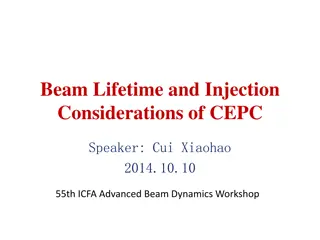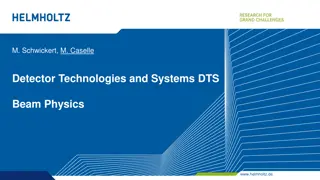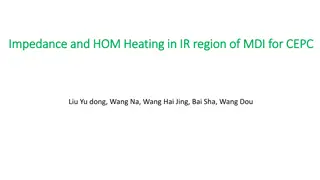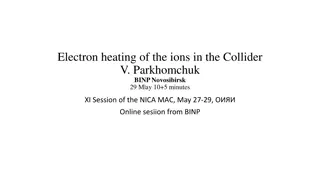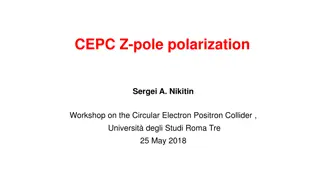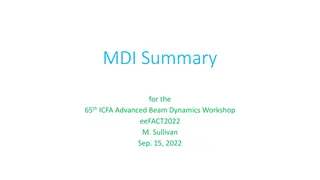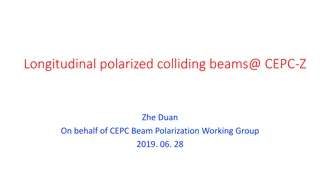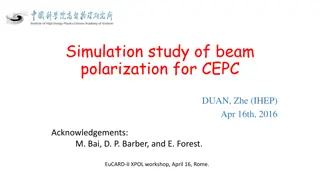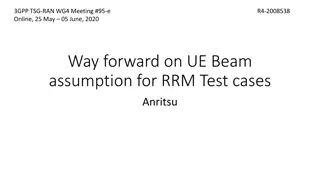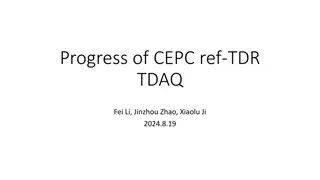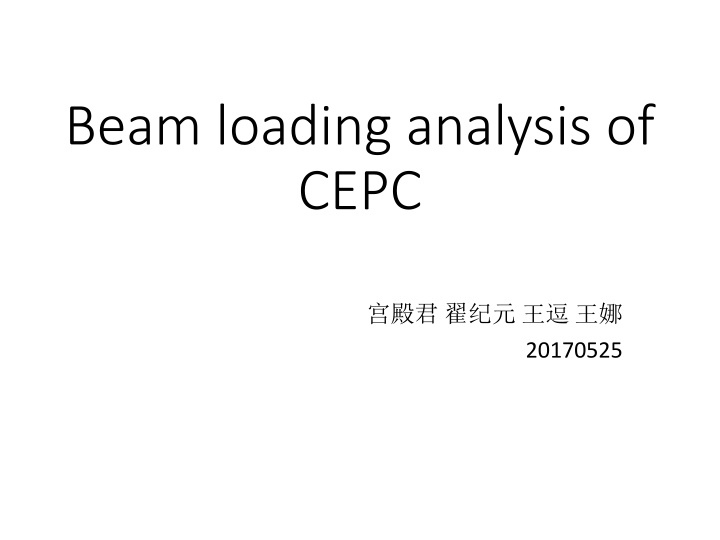
Fundamental Mode Instability and Beam Loading Analysis at CEPC
Explore the beam loading effects and coupled bunch instabilities in large storage rings like CEPC. Learn about fundamental mode instability, phase shifts, and damper systems to address these issues for optimized operation.
Download Presentation

Please find below an Image/Link to download the presentation.
The content on the website is provided AS IS for your information and personal use only. It may not be sold, licensed, or shared on other websites without obtaining consent from the author. If you encounter any issues during the download, it is possible that the publisher has removed the file from their server.
You are allowed to download the files provided on this website for personal or commercial use, subject to the condition that they are used lawfully. All files are the property of their respective owners.
The content on the website is provided AS IS for your information and personal use only. It may not be sold, licensed, or shared on other websites without obtaining consent from the author.
E N D
Presentation Transcript
Beam loading analysis of CEPC 20170525
Introduction There are two particular beam loading effects presenting in large high-current storage rings: First, the phase shift and voltage decrease between the bunches due to gaps in the bunch train; Second, the longitudinal coupled bunch instability (CBI) due to the detuned fundamental RF resonance.
Outline Beam loading analysis of CEPC DR Fundamental mode instability of Z-pole Phase shift of Z-pole Beam loading of CEPC APDR
Fundamental Mode Instability of Z-pole Fundamental mode CBI of Z-pole due to large cavity bandwidth and detuning. For M bunches, there are M coupled-bunch modes, the phase shift between adjacent bunches for mode number n: Dfn=2p n = 0, 1, 2, ... M-1 Mn CBI growth rate : I ( ) ( ) + + = 1 || || Re Re b c f Z f f Z f p p p p 2 E = 0 p s s += (pM + ) f0+ fs Kouki Hirosawa. Development of a coupled bunch instability damper caused by the acceleration mode for SuperKEKB. PASJ2016 TPU012 fp = [(p+1)M ] f0+ fs fp We refer to the mode =M-n as the mode = -n
Cavity resonance frequency Longitudinal coupling-impedance = + f f f ?||(?) =1 ?? 2 ???? ???? res rf 1 + ???(? R QfRF ? Ibsinfs ? Dfopt= - 2Vc Optimal detuning Growth time of CBI due to acceleration mode of CEPC Z operation (10 modes to be damped) Cavity acceleration mode impedance and beam spectrum of CEPC Z-pole mode
Damper system for fundamental mode instability Use the mode by mode damper system with digital filters to suppress unstable modes. (SuperKEKB) Damper system for SuperKEKB: Kouki Hirosawa. Development of a coupled bunch instability damper caused by the acceleration mode for SuperKEKB. PASJ2016 TPU012 Functional block diagram of digital filter for SuperKEKB
Phase shift of Z-pole There are two kinds of filling patterns for CEPC Z-pole: 1. A long bunch train (330??) with an 1% gap. 2. 1065 bunch trains, 1 bunch every 4 buckets. In consideration of suppressing fast beam ion instability(FBII). RF parameters for Z-pole phase shift calculation: Parameters Number Unit Bunches/beam 21300 Bunch charge 7.3 nC Beam current 466 mA Bunch spacing 16 Ns Revolution time 333.3 ?? RF voltage 0.14 GV Acc. phase 75.9 deg Cavity voltage 2.9 MV Unloaded Q 1E+5 Opt loaded Q 1.2E+5 Opt. detuning 10.9 kHz Cavity filling time 58.3 ??
1. Phase shift in a long bunch train with an 1% gap. P.B. Wilson s formula can be used if precondition is met: the gap time is small compared to the cavity filling time. In CEPC Z-pole 1% gap ?? ??= 0.057<<1, this means the beam-induced voltage recovers very closely to the steady state after the passage of the gap. The voltage change after the arrival of the gap: = = ( / R Q I T 2 ) [ /( )] V k q T T T 0 0 0 l g g If ? can be approximated as: ?? 1, the phase shift after the passage of the gap = + ' ( ) V V + + 2 1/2 sin (tan 2 cos ) tan V V c c P.B. Wilson. Fundamental-Mode rf Design in ?+? Storage Ring Factories. SLAC- PUB-6062,1993 In CEPC Z-pole 1% gap V V = / 0.234 c = 13.82deg max
2. Phase shift of short bunch trains 21300 bunches, 1065 equal trains, 20 bunches each ???? ???????:??= 6.15?? Gap interval: ??= 195.7?? ??????? ???? ?? ?? ? ? ???:??= ??/?? 1 = 31 ???? ?????? ??? ?????: ? = 20 ??= 1.2 105 = 2? 10.9kHz The duty ratio is 37.4% If the deviation in bunch position is small: ? 1 the beam induced voltage of bunch n can be written as: 1 sin 2 2 (1 1 1 sin ( ) 2 K. Bane, K. Kubo, P.B. Wilson. Compensatiing the unequal bunch spacing in the NLC damping rings. EPAC96 N b kq e g n b = ( /2) i n N ) V e b i b + N N b g rf = + i = ?0 ?rf 2 Q L N T = 0.0135 = For short train or short gap, CEPC Z-pole: the maximum voltage decrease in a train can be written as = + For CEPC Z short bunch trains: 0.0087 NT g b b ( 1) N N N N 2 V V kq g 1 N sin V 0 0 0 c c g V V = 0.76deg = 1.28% 1 N 1 N c
3. Comparison of two calculation methods For CEPC Z-pole, the storage ring filled with one bunch train with an uncertain gap. We calculate the shift in bunch phase in both two methods: ?1:the phase shift with P. B. Wilson s formula ?2: the phase shift with K. Bane s formula Phase shift vs. gap ratio calculated in two methods When the gap ratio is below 5%, the results are nearly same with each other. As the gap ratio is too large, not only the gap interval can be compared to filling time, but also the gap length is not short. So the application conditions of two methods can t be met. N T g b
Beam loading of CEPC APDR (1) APDR(100km 4+4DR) RF Parameters Based on Wangdou_20170426_100km machine parameters 100 km, double ring, 2 Ips, 8 RF stations 8 2.5km DR Based on WD20170426 Higgs (high-Lumi) Z Higgs Z (high-Lumi) Beam Energy [GeV] Luminosity / IP [1034cm-2s-1] SR power / beam [MW] RF freqeuncy [MHz] Momentum compaction (10-5) Bunch length [mm] RF voltage [GV] Beam current / beam [mA] Pulse current [mA] Bunch charge [nC] Bunches / beam Bunches/ train Bunch spacing [ns] Effective length / cell [m] R/Q [ ] HOM power / cavity [kW] Cavity number (total) Gradient [MV/m] Acc. phase [deg] Input power / cavity [kW] 120 2 32 650 1.14 2.9 2.1 19.2 191.6 15.5 412 103 80.9 0.46 213 0.20 336 13.6 37.3 95 45.5 1.1 1.4 650 1.14 4 0.05 40.8 408.5 4.9 2770 693 12.0 0.46 213 0.11 16 6.8 47.2 175 120 3.1 50 650 1.14 2.9 2.1 30 299.5 15.5 644 161 51.8 0.46 213 0.32 336 13.6 37.3 149 45.5 12 16.1 650 4.49 4 0.14 466 4730.4 7.3 21600 5400 1.5 0.46 213 1.84 96 6.3 75.9 335
100 km, double ring, 2 Ips, 8 RF stations 8 1km DR Based on WD201704262 H Z H Z (baseline) (1E+34 (high-Lumi) (high-Lumi) Unloaded Q0 Wall loss / cavity @ 2 K [W] Pulse power/ cavity [MW] Opt. QL Opt. detuning [kHz] Cavity bandwidth [kHz] Cavity stored energy [J] Max relative voltage drop for 4+4 APDR [MV] Max bunch train phase shift for 4+4 APDR [deg] 1E+10 19 0.95 1.0E+06 0.25 0.7 46 1E+10 19 1.74 2.7E+05 1.29 2.4 12 1E+10 19 1.49 6.4E+05 0.39 1.0 46 1E+10 4 3.35 3.1E+04 42.18 21.1 3 8.5% 36.6% 13.3% / 7.7 / 13.9 / The phase shifts are calculated with K. Bane s formula, for Higgs, Higgs_high lumi and Z, the formula s application condition (both short train and short bunch) is met. For Higgs, the phase shift is 7.7 deg, which will cause 1% RF acceptance decrease. For Z, the voltage drop is 36.6%. As a result, the effective voltage seen by the last bunch is lower than its SR loss. So it can t receive enough energy from the RF cavity to compensate the SR loss. For Z_high lumi, the cavity bandwidth is 7 times as large as rev. freq. Besides, its opt. detuning freq. is 42kHz, CBI of it is a very serious problem. As a result of large phase shift, when the last bunch of each train passes the RF cavity, it will be decelerated. The phase shift can cause luminosity reduction and beam performance deterioration.
(2) CBI growth time Growth time of CBI due to acceleration mode of CEPC APDR Higgs Growth time of CBI due to acceleration mode of CEPCAPDR Z Two fundamental modes are unstable, when the current reach the design current 40.8mA. All fundamental modes are stable.
(3) RF parameter of APDR Z different design 100 km, double ring, 2 Ips, 8 RF stations 8 2.5km DR Based on WD20170426 Z Z Z Z (high-Lumi) (1*10^34) (low-charge_1) (low-charge_2) Luminosity / IP [1034cm-2s-1] Beam Energy [GeV] SR loss / turn [GV] SR power / beam [MW] RF freqeuncy [MHz] Momentum compaction (10-5) Bunch length [mm] RF voltage [GV] Beam current / beam [mA] Pulse current/ beam [mA] Bunch charge [nC] Bunches / beam Bunches/ train Bunch spacing in a train [ns] Syncrotron phase from crest [deg] Acc. Gradient [MV/m] Cavity number Cavity voltage [MV] HOM power/ cavity [kW] Input power/ cavity [kW] Effective length /cell [m] R/Q per cavity [ ] 12 45.5 0.034 16.1 650 4.49 4 0.14 466 4730 7.3 21600 5400 1.1 45.5 0.034 1.4 650 1.14 4 0.05 40.8 408 4.9 2770 693 12.0 47.2 6.79 16 3.13 0.1 175 0.23 213 0.19 45.5 0.034 1.4 650 4.49 4 0.14 41 409 1.36 10000 2500 3.3 75.9 19.02 16 8.75 0.03 174 0.23 213 0.33 45.5 0.0034 0.8 650 1.14 4 0.047 25 245.4 1.36 6000 1500 5.6 43.7 12.77 8 5.88 0.02 209 0.23 213 1.5 (1 bucket) 75.9 3.17 96 1.46 1.8 335 0.23 213
100 km, double ring, 2 Ips, 8 RF stations 8 2.5km DR Based on WD20170426 Z Z Z Z (high-Lumi) (1*10^34) (low-charge_1) (low-charge_2) Unloaded Q0 Opt. QL Opt. detuning [kHz] Cavity bandwidth [kHz] Cavity stored energy [J] Total wall loss @ 4.5 K eq. [MW] Voltage decrease Phase shift 1E+10 3.1E+4 42.2 21.1 3 0.4 decelerated / 1E+10 2.7E+5 1.29 2.4 12 0.3 36.6% / 1E+10 2.1E+6 0.61 0.3 91 2.1 13.1% 2.2 1E+10 8.0E+5 0.39 0.8 41 0.5 11.7% 8.7 For Z(L=1*10^34), both phase shift and bunch lengthening are serious problems. For Z low charge (q=1.36nC), if we choose the large beam emittance, make the beam current equal to the DR s, the phase shift is only 2deg, but the Luminosity is only 2E+33. If we choose the small beam emittance, the maximum bunch number that the 8-cavity RF system can endure is 9000, the phase shift is 15deg. As the bunch number is decreased to 6000, its phase shift is 8.7deg, which is in the same level with H_baseline.
4Phase shift and RF energy acceptance For Z_low charge (small emittance): The maximum bunch number is 9000, we choose 6000 for RF system. RF energy acceptance vs. Bunch number:


